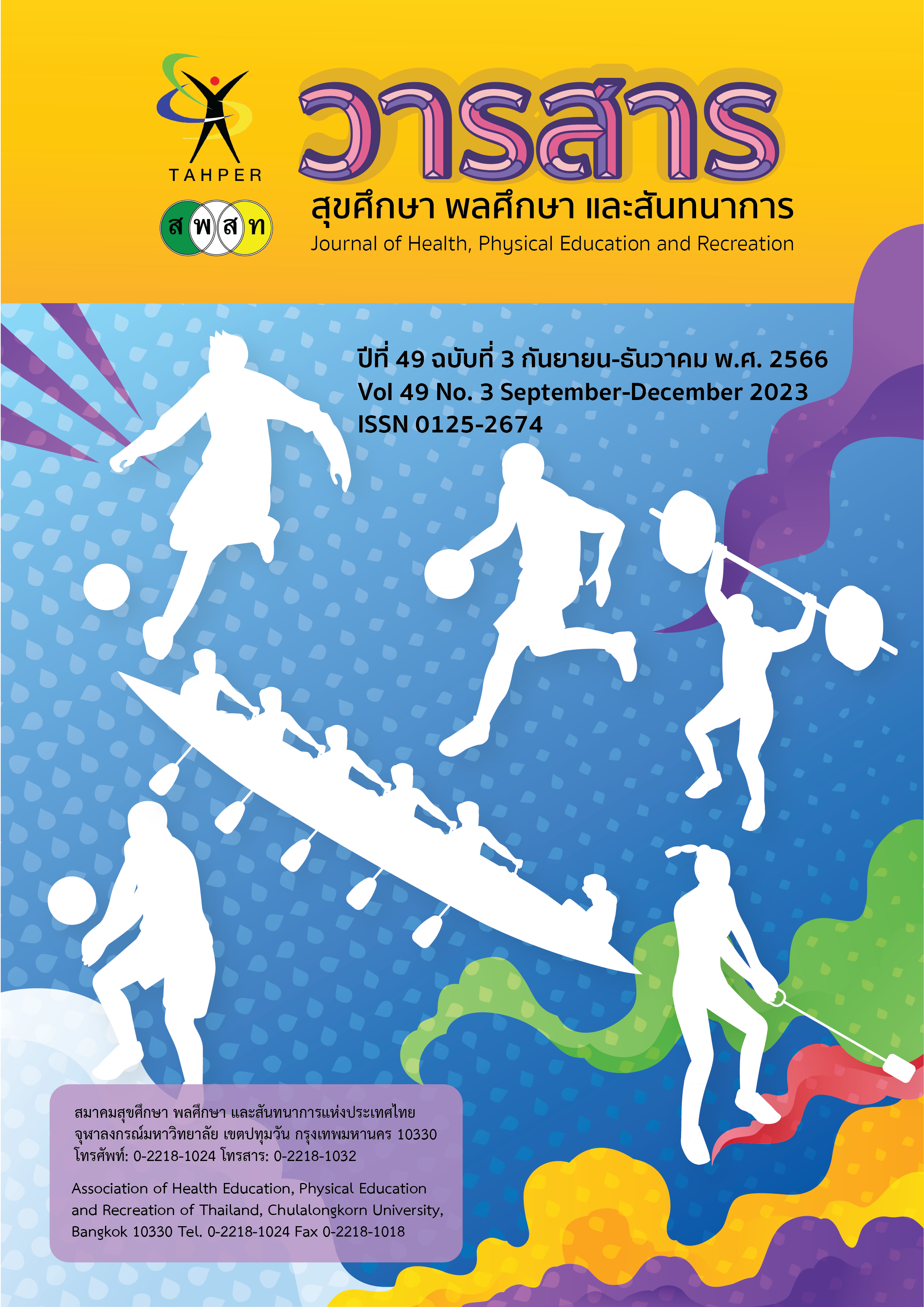Guidelines for Developing Competition Management Strategies of the Netball Association of Thailand
Main Article Content
Abstract
This research is a study of the system, process and opinions in the organization of the Netball Association of Thailand, in order to analyze the problems arising from competition and to determine guidelines for the development of competition management strategies, with experts in sports management and those involved in the prize, a total of 417 people. A total of five questionnaires were created by researchers. Each questionnaire had a content validity (IOC) between 0.80-1.00 and a confidence value and a reliability greater than 0.90. The results showed that Sports Association Management specialists had opinions on the management system of the competition had an average of 3.73 and a standard deviation value of 0.45. The association management committee and the opinions of referees on the management process has an average of 3.60 and a standard deviation value of 0.47. The opinions of coaches and athletes on the management process with an average of 3.35 and a standard deviation value of 0.51. The opinions of the viewers and cheerleaders had opinions on the management of the competition with an average of 3.31 and a standard deviation value of 0.61. Athletes had opinions on the training of athletes with an average of 3.31 and a standard deviation value of 0.58. Then the researcher used the data to analyze SWOT analysis of both internal and external factors, as well as set the vision and mission of the Netball Association of Thailand and formulate the strategic guidelines for improving the management of the competition, as follows: (1) Corporate Strategy is the vision, mission and the objectives, including growth, to promote the development strategies of the Netball Association by focusing on expertise in the field of operations to achieve efficiency (2) Business Strategy is an improvement in sporting events. Therefore, differentiation strategies were used to create added value for the development of more competence and knowledge, as well as to respond to the needs of those involved in sports associations and competitions (3) Functional strategy showing correlation and dissimilarity. This defines the functions of marketing, finance, production and human resources management. Therefore, establishing a function-level strategy is important in achieving their goals, including suggestions and control of work to ensure the work, according to quality and efficiency plans.
Article Details

This work is licensed under a Creative Commons Attribution-NonCommercial-NoDerivatives 4.0 International License.
Critical thinking in journals is the right of the author. The Association of Health Education, Physical Education and Recreation of Thailand is not always required, to create diversity in ideas and creativity.
ความคิด ข้อวิพากษ์ในวารสารเป้นสิทธิของผู้เขียน สมาคมสุขศึกษา พลศึกษา และสันทนาการแห่งประเทศไทยไม่จำเป็นต้องเห็นชอบด้วยเสมอไป เพื่อให้เกิดความหลากหลายในความคิดและความสร้างสรรค์
References
กระทรวงการท่องเที่ยวและกีฬา. (2550). แผนพัฒนาการกีฬาแห่งชาติ ฉบับที่ 4 (พ.ศ. 2550-2554). กรุงเทพฯ: กระทรวงการท่องเที่ยวและกีฬา.
กระทรวงการท่องเที่ยวและกีฬา. (2555). แผนพัฒนาการกีฬาแห่งชาติ ฉบับที่ 5 (พ.ศ. 2555-2559). กรุงเทพฯ: กระทรวงการท่องเที่ยวและกีฬา.
กิติศักดิ์ คลังดิษฐ์. (2559). แนวทางการพัฒนาการจัดการแข่งขันกีฬาแฮนด์บอลชายหาดในการแข่งขันกีฬานักเรียนนักศึกษาแห่งชาติ. ปริญญานิพนธ์ศิลปศาสตรมหาบัณฑิต. สาขาการจัดการกีฬาและนันทนาการ. มหาวิทยาลัยศรีนครินทรวิโรฒ.
เนตร์พัณณา ยาวิราช. (2546). การจัดการสมัยใหม่ (พิมพ์ครั้งที่ 2). กรุงเทพฯ: เซ็นทรัลเอ็กซ์เพรส.
ณัฏฐพันธ์ เขจรนันท์. (2552). การจัดการเชิงกลยุทธ์ (ฉบับปรับปรุงใหม่). กรุงเทพฯ: ซีเอ็ดยูเคชั่น.
ภาวินี ชุ่มใจ. (2565). รูปแบบการบริหารจัดการศูนย์กีฬาในมหาวิทยาลัย. วารสารสุขศึกษา พลศึกษา
และสันทนาการ. 48(2). 28-41.
สุปราณี ขวัญบุญจันทร์. (2547). เอกสารการฝึกอบรมผู้ฝึกสอนกีฬาเนตบอล. กรุงเทพฯ: สมาคมกีฬาเนตบอล
สมัครเล่นแห่งประเทศไทย ร่วมกับสำนักพัฒนาการกีฬาและนันทนาการ.
อภิวัฒน์ ปัญญามี. (2565). แนวทางการพัฒนาบริการทางการกีฬาและการออกกำลังกายในสถาบันพลศึกษา.
วารสารสุขศึกษา พลศึกษา และสันทนาการ. 48(1). 60-74.
Drucker, P. F. (1954). The Practice of Management. New York. Harper & Row.


